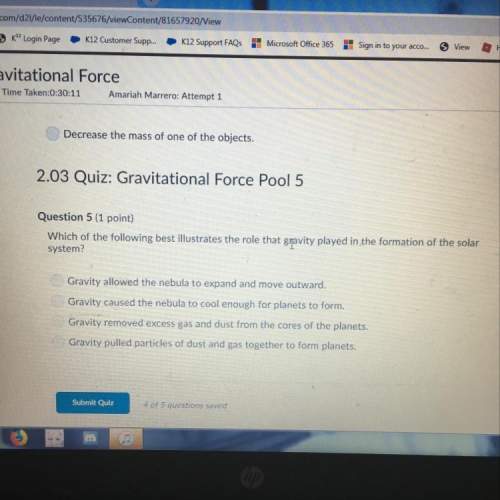A.

Chemistry, 24.03.2021 22:10 yselahernandez02
Which of the following best describes H2(g) + Cl2(g) 2HCl(g), H = -184.6 kJ/mol?
close
A.
The reaction is endothermic.
B.
The reaction requires heat.
C.
The reaction produces heat.
D.
The reaction has no activation energy.
The answer is C. The reaction produces heat.

Answers: 1
Another question on Chemistry

Chemistry, 21.06.2019 23:00
Select the correct answer. given: 2libr + ba → babr2 + 2li in this chemical reaction, 325 grams of barium (ba) react completely. how many moles of lithium (li) are produced? a. 1.18 mol b. 2.37 mol c. 4.73 mol d. 16.4 mol e. 32.9 mol
Answers: 2

Chemistry, 22.06.2019 02:20
6. what does the symbol ah stand for? o one calorie given off by a reaction the specific heat of a substance the heat capacity of a substance the heat of reaction for a chemical reaction
Answers: 1

Chemistry, 22.06.2019 03:00
In the 1800s, one of the statements in john dalton's atomic theory was that atoms are indivisible. later experimental evidence led to the discovery of subatomic particles such as neutrons, electrons, and protons. what happened to the indivisible atom part of dalton's atomic theory, and why?
Answers: 3

Chemistry, 22.06.2019 13:30
In a ni-cd battery, a fully charged cell is composed of nickelic hydroxide. nickel is an element that has multiple oxidation states. assume the following proportions of the states: nickel charge proportions found 0 0.17 +2 0.3 +3 0.33 +4 0.5 (a) determine the mean of the nickel charge. enter the answer to 2 decimal places.(b) determine the cumulative distribution function of nickel charge.
Answers: 2
You know the right answer?
Which of the following best describes H2(g) + Cl2(g) 2HCl(g), H = -184.6 kJ/mol?
close
A.
A.
Questions


Mathematics, 18.10.2020 05:01

History, 18.10.2020 05:01

Business, 18.10.2020 05:01

English, 18.10.2020 05:01


Mathematics, 18.10.2020 05:01

Mathematics, 18.10.2020 05:01

English, 18.10.2020 05:01

Mathematics, 18.10.2020 05:01

English, 18.10.2020 05:01

History, 18.10.2020 05:01

Mathematics, 18.10.2020 05:01


Biology, 18.10.2020 05:01

Mathematics, 18.10.2020 05:01

English, 18.10.2020 05:01

Mathematics, 18.10.2020 05:01


Mathematics, 18.10.2020 05:01




